Winter Driving in America Funny Video
Back to Social Media
Social Media: Winter Driving
#WeatherReady
Please help the NWS spread these messages on social media! Everyone is welcome to use the text and images provided below to help the NWS build a Weather-Ready Nation.
- Bridges Freeze First
- Freezing Rain
- Black Ice
- Avalanches While Driving
- Winter Travel Timeline (video)
- Winter Road Trip Safety
- Winter Vehicle Prep (video)
- Snow Squalls & WEAs
- First Snow
- Sun Glare
- Rain with a Temperature Near Freezing
- Freezing Drizzle
- Flash Freeze
- Rain After a Long Dry Stretch
- Dense Fog
- Snow Squalls
- Ice and Snow, Take it Slow
Bridges Freeze First
Facebook
You've probably seen road signs advising that bridges freeze before roads, but do you know why? Having open air underneath the bridge means the cold air surrounds the bridge both above and below.
If there's even the chance that a bridge might be frozen, SLOW DOWN! And do it before you cross the bridge — changing speed on ice is dangerous.
weather.gov/safety/winter
Twitter
You've probably seen road signs advising that bridges freeze before roads, but do you know why? Having open air underneath the bridge means the cold air surrounds the bridge both above and below. weather.gov/safety/winter #WeatherReady
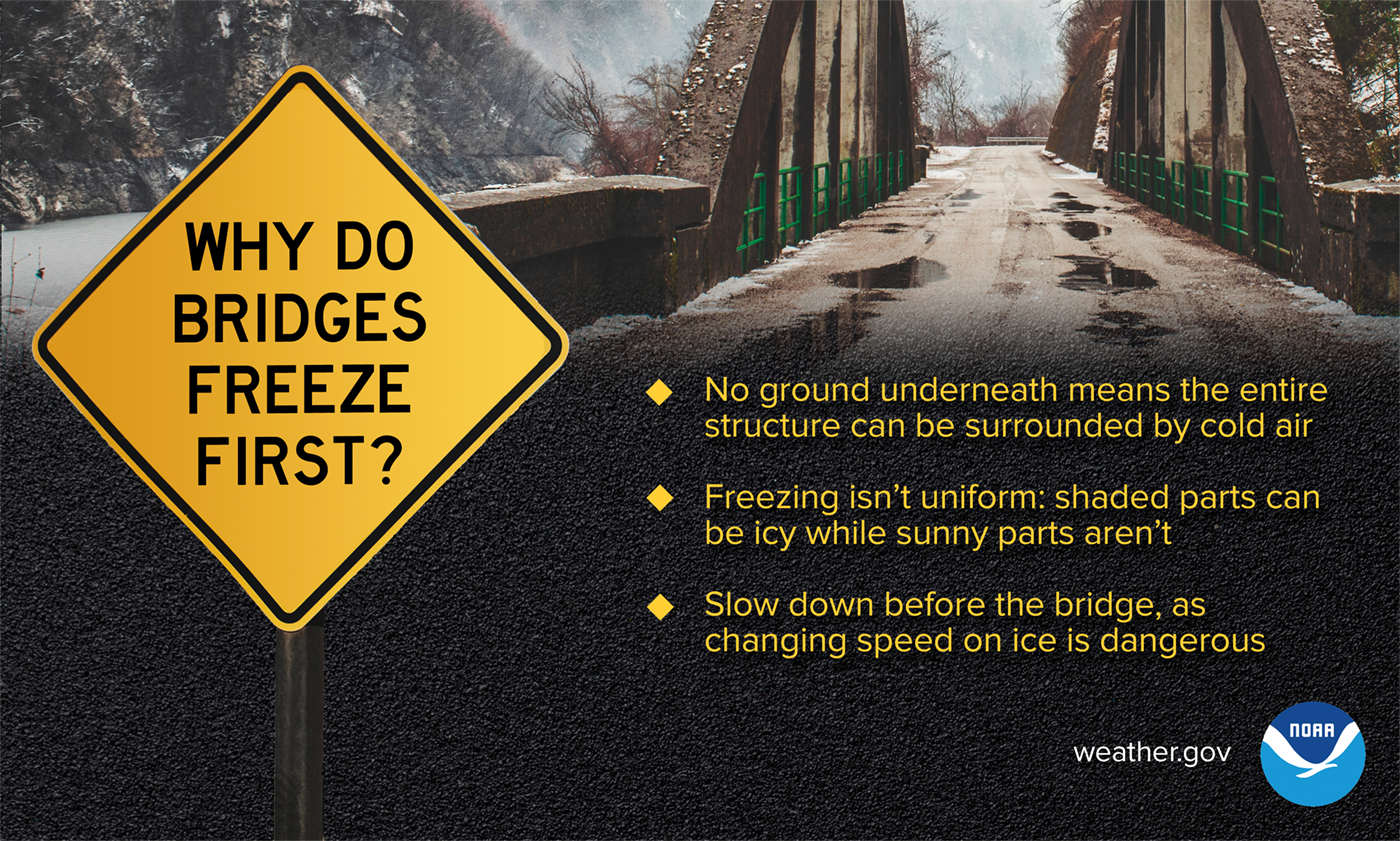
![]()
Freezing Rain
Facebook
Compared to a typical snowstorm, freezing rain is much more hazardous — especially on the road. While both are dangerous, it's far easier to lose control of your vehicle on icy pavement, not to mention the increased risk of falling branches and powerlines.
Bottom line: use extreme caution if there is, or recently was, freezing rain.
weather.gov/safety/winter
Twitter
Compared to a typical snowstorm, freezing rain is much more hazardous — especially on the road.
Bottom line: be #WeatherReady and use extreme caution if there is, or recently was, freezing rain.
weather.gov/safety/winter
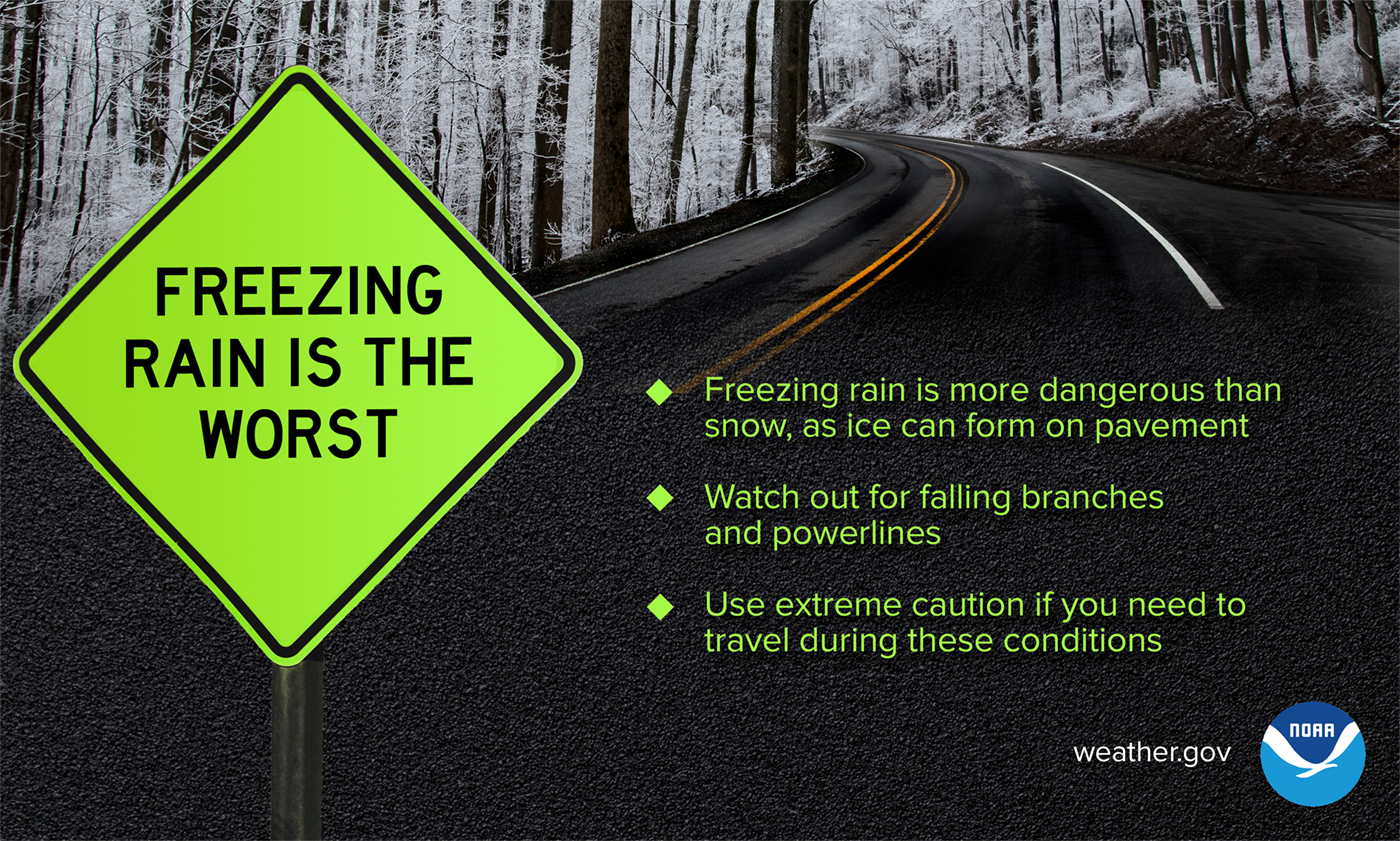
![]()
Black Ice
Facebook
When recent rain or snowmelt comes into contact with freezing temperatures, black ice can form — and you might not even see it. And while black ice is more prevalent at night, it can often stick around for the morning commute. Use extreme caution when driving...don't let black ice sneak up on you.
weather.gov/safety/winter
Twitter
Don't let black ice sneak up on you! When recent rain or snowmelt comes into contact with freezing temperatures, black ice can form — and you might not even see it.
weather.gov/safety/winter #WeatherReady
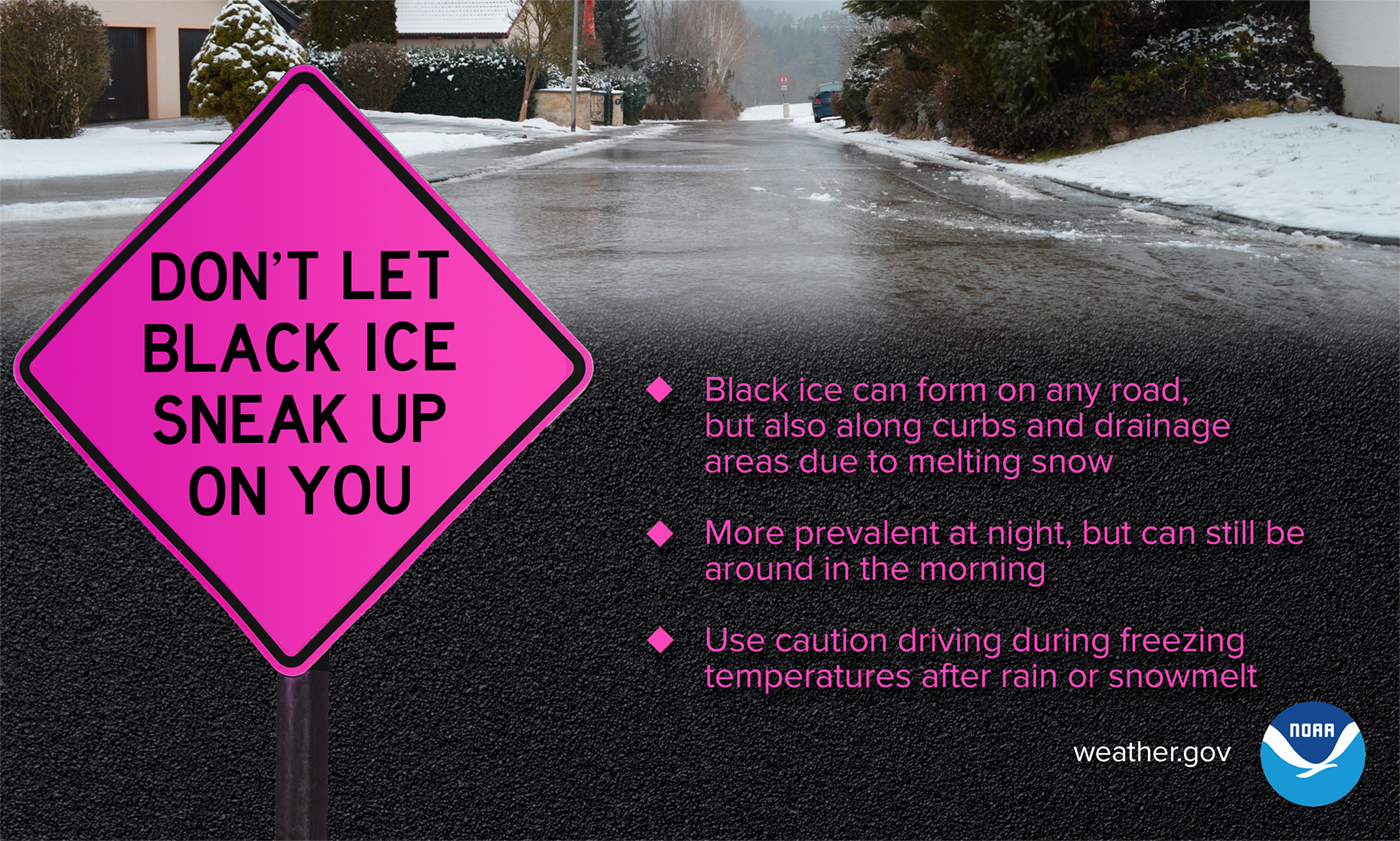
![]()
Avalanches While Driving
Facebook
Avalanches can pose a very real danger to drivers on mountain roads. If you are caught in an avalanche, stay in your vehicle and turn off the engine to avoid carbon monoxide poisoning from a clogged tailpipe.
Avoid danger in the first place by heeding warning signs and not driving around barriers - and be Weather-Ready by equipping your car with an emergency kit.
weather.gov/safety/winter-avalanche
Twitter
Avalanches can pose a very real danger to drivers on mountain roads. If you are caught in an avalanche, stay in your vehicle and turn off the engine to avoid carbon monoxide poisoning from a clogged tailpipe. weather.gov/safety/winter-avalanche
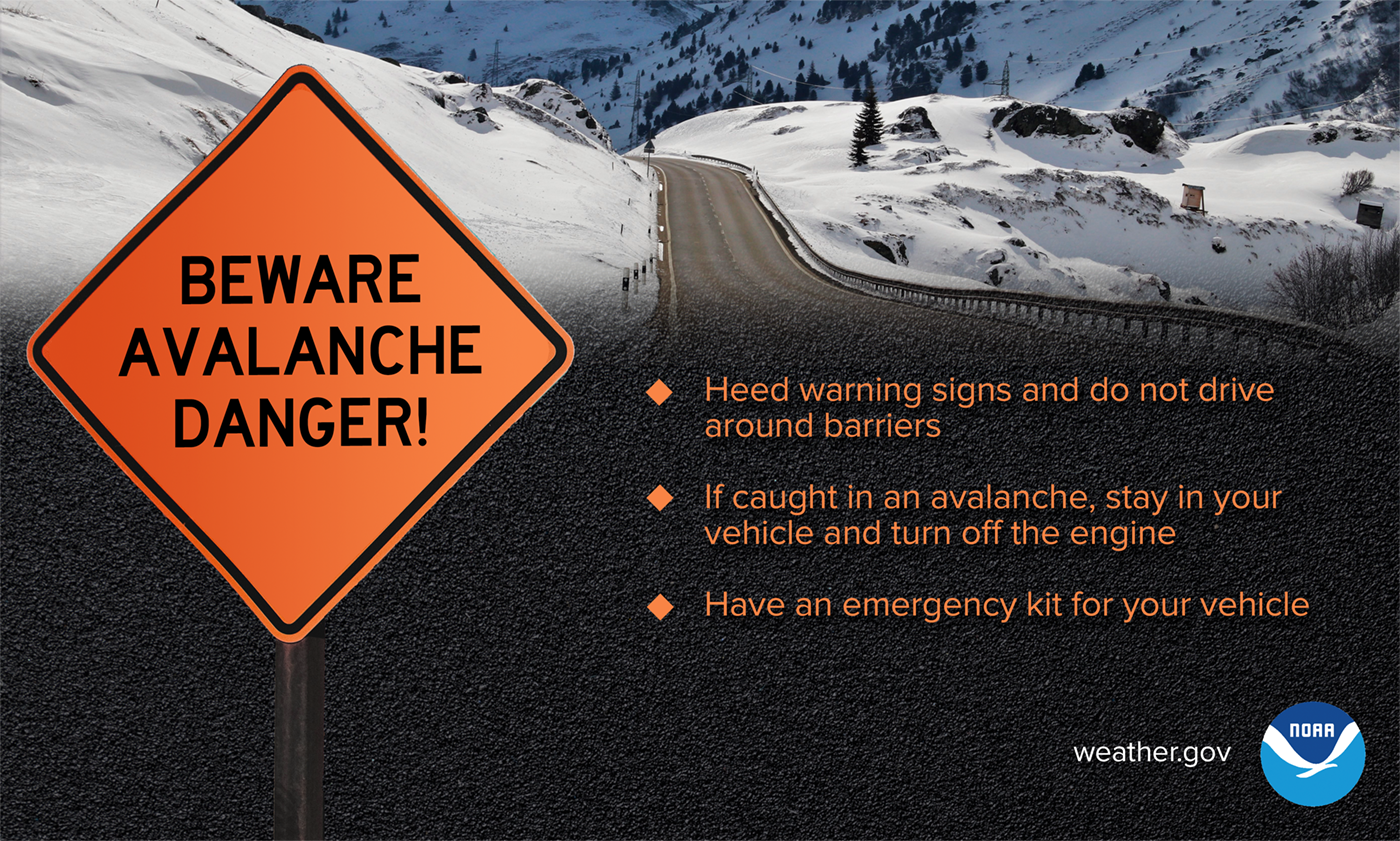
![]()
Winter Travel Timeline (Video)
Facebook
Are you planning a lengthy trip by car this winter? Know how to prepare, and know that the decisions that need to be made will differ depending on where you are on the Winter Travel Timeline: youtu.be/ZzjarXUsDtA
Twitter
Are you planning a lengthy trip by car this winter? Know how to prepare, and know that the decisions that need to be made will differ depending on where you are on the Winter Travel Timeline: youtu.be/ZzjarXUsDtA #WeatherReady
Winter Road Trip Safety
Facebook
If you're going to be driving this winter, know how to stay safe. Winterize your vehicle and pack an emergency supply kit. Share your travel plans with friends and family. Before leaving, check road conditions and the weather forecast so you know to expect. weather.gov/safety/winter
Twitter
If you're going to be driving this winter, know how to stay #WeatherReady. Winterize your vehicle and pack a supply kit. Share your travel plans, and before leaving, check road conditions and the weather forecast. weather.gov/safety/winter
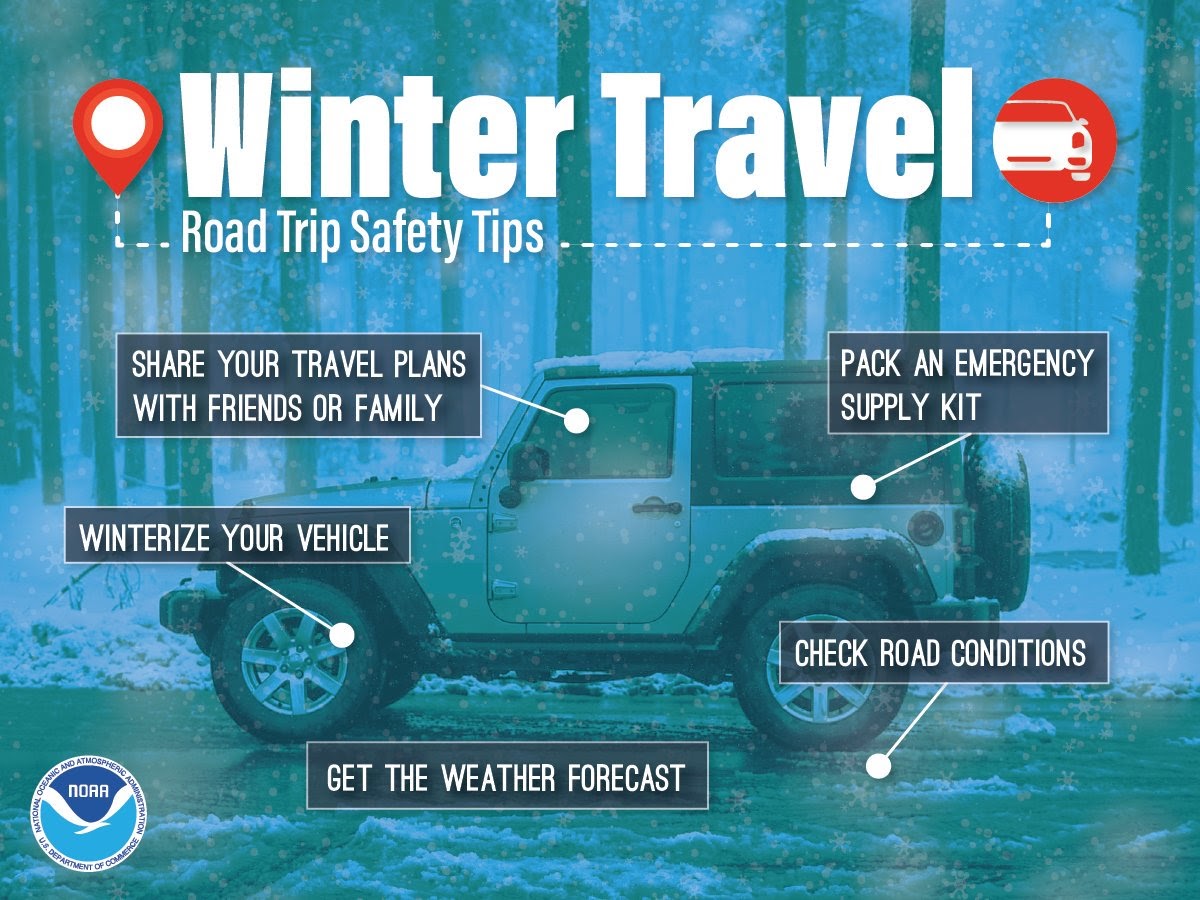
![]()
Winter Vehicle Prep (Video)
Facebook
Is your vehicle ready for the winter? Watch this brief video to know what needs to be in your emergency kit and how to winterize your vehicle: youtu.be/hcwl_bnID50
Twitter
Is your vehicle ready for the winter? Watch this brief video to know what needs to be in your emergency kit and how to winterize your vehicle: youtu.be/hcwl_bnID50
#WeatherReady
Snow Squalls & WEAs
Facebook
Snow squalls are intense bursts of snow and wind with whiteout visibility that are extremely dangerous, especially while on the road. The National Weather Service helps you be ready by issuing Snow Squall Warnings that can trigger a Wireless Emergency Alert on your phone. If you receive one, know that a snow squall is occurring or imminent, and slow down or delay travel. weather.gov/safety/winter-snow-squall
Twitter
Snow squalls are extremely dangerous while on the road. NWS helps you be #WeatherReady by issuing Snow Squall Warnings that can trigger a Wireless Emergency Alert on your phone. When issued, slow down or delay travel. weather.gov/safety/winter-snow-squall
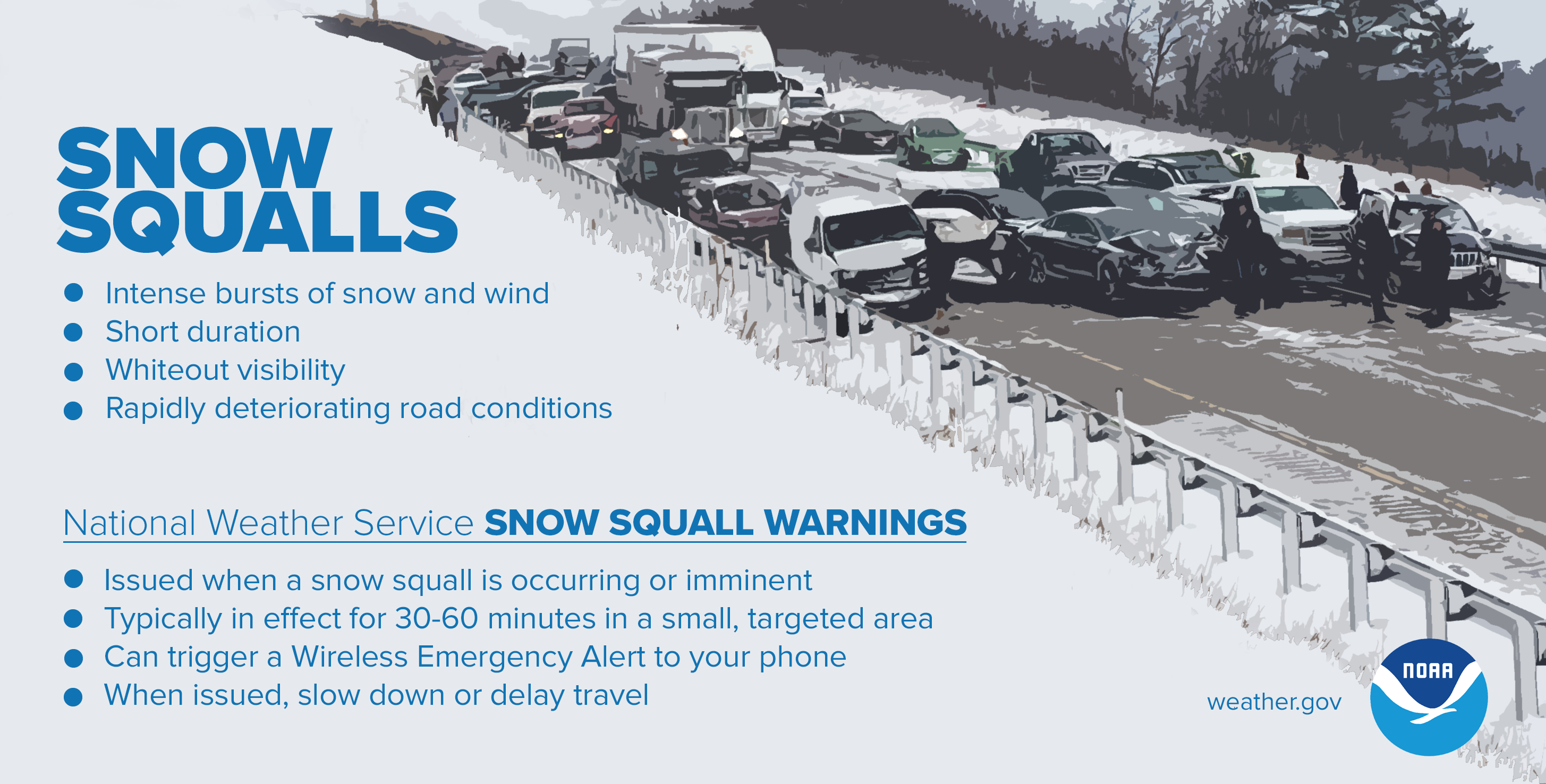
![]()
First Snow
Facebook
While lots of snow in the middle of winter can certainly cause dangerous travel conditions, many times it's the first little bit of snow of the season that can cause accidents. Be extra careful as you and other drivers adjust to driving in poor conditions. Slow down, don't use cruise control, and keep your distance from other vehicles. Don't let the first snow sneak up on you!
Twitter
While lots of snow in the middle of winter can cause dangerous travel conditions, the first little bit of snow of the season can also cause accidents. Be careful as you and other drivers adjust to driving in poor conditions. Don't let the first snow sneak up on you! #WeatherReady
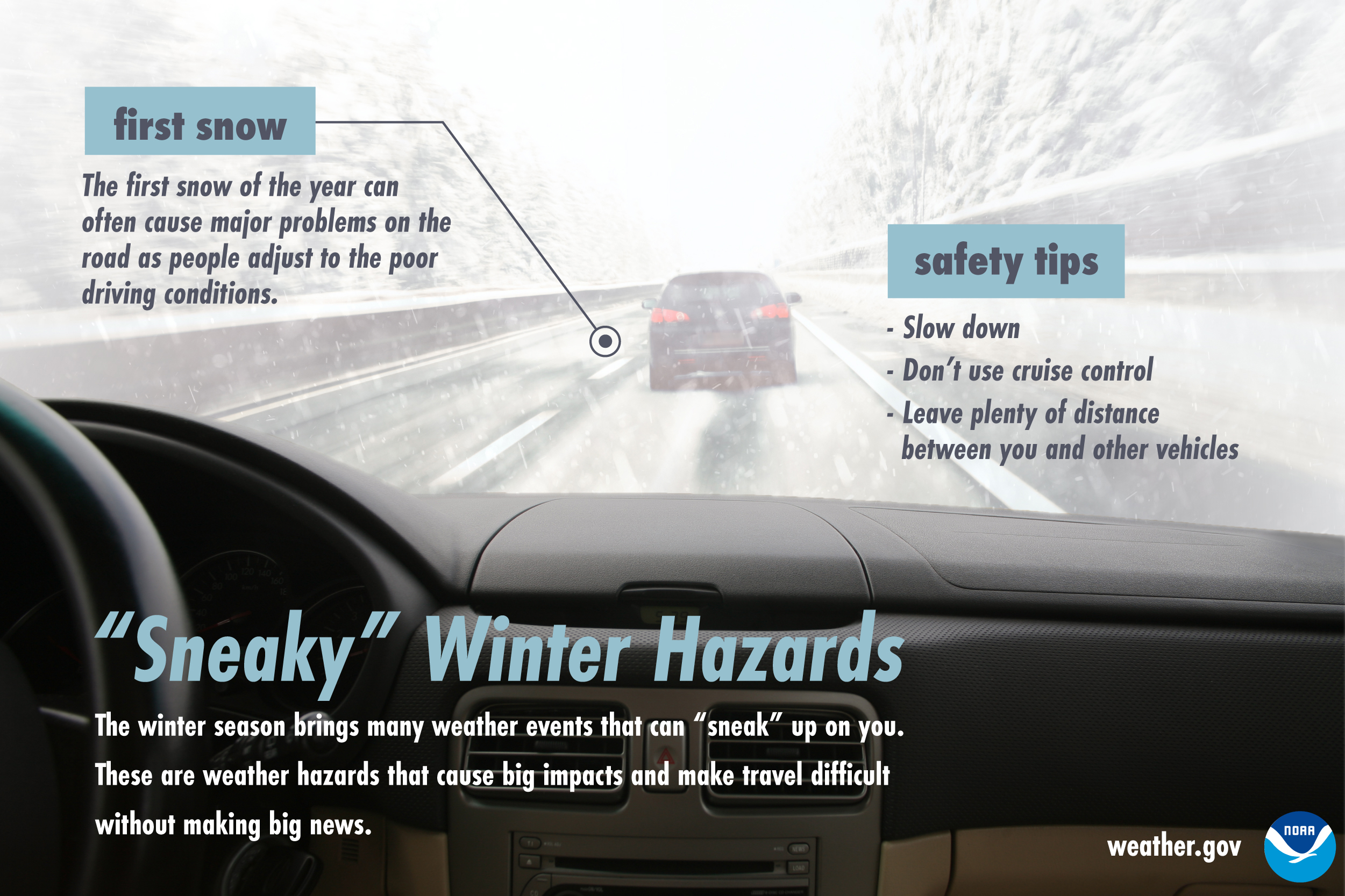
![]()
Sun Glare
Facebook
Even on a nice winter day, the low sun angle can make driving hazardous. Freshly-fallen snow can add more glare to your drive. Have a pair of sunglasses on hand, slow down, and leave plenty of distance between you and other vehicles. Don't let sun glare sneak up on you!
Twitter
The low sun angle, especially combined with freshly-fallen snow, can cause a glare that makes driving difficult. Keep a pair of sunglasses handy and slow down. Don't let sun glare sneak up on you! #WeatherReady
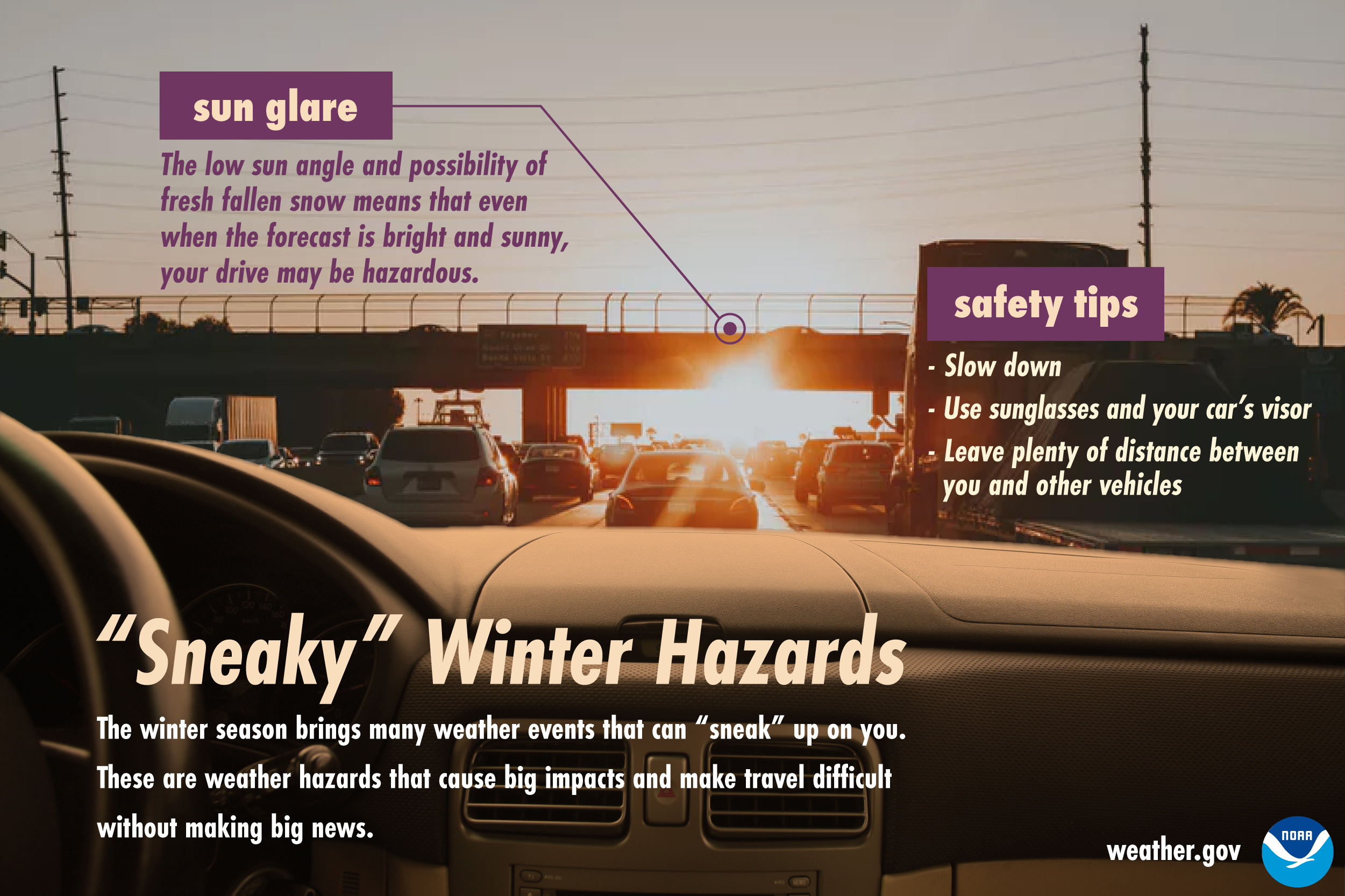
![]()
Rain with a Temperature Near Freezing
Facebook
Rain may seem like less of a winter driving hazard than snow, but when temperatures are near freezing, that's not the case. Ice can form quickly and make roads slick. In these conditions, slow down, don't use cruise control, and keep plenty of distance between you and other vehicles. Don't let this winter hazard sneak up on you!
Twitter
Rain may seem like less of a winter driving hazard than snow, but when temperatures are near freezing, that's not the case. Ice can form quickly and make roads slick. Be extra careful in these conditions, and don't let this winter hazard sneak up on you! #WeatherReady
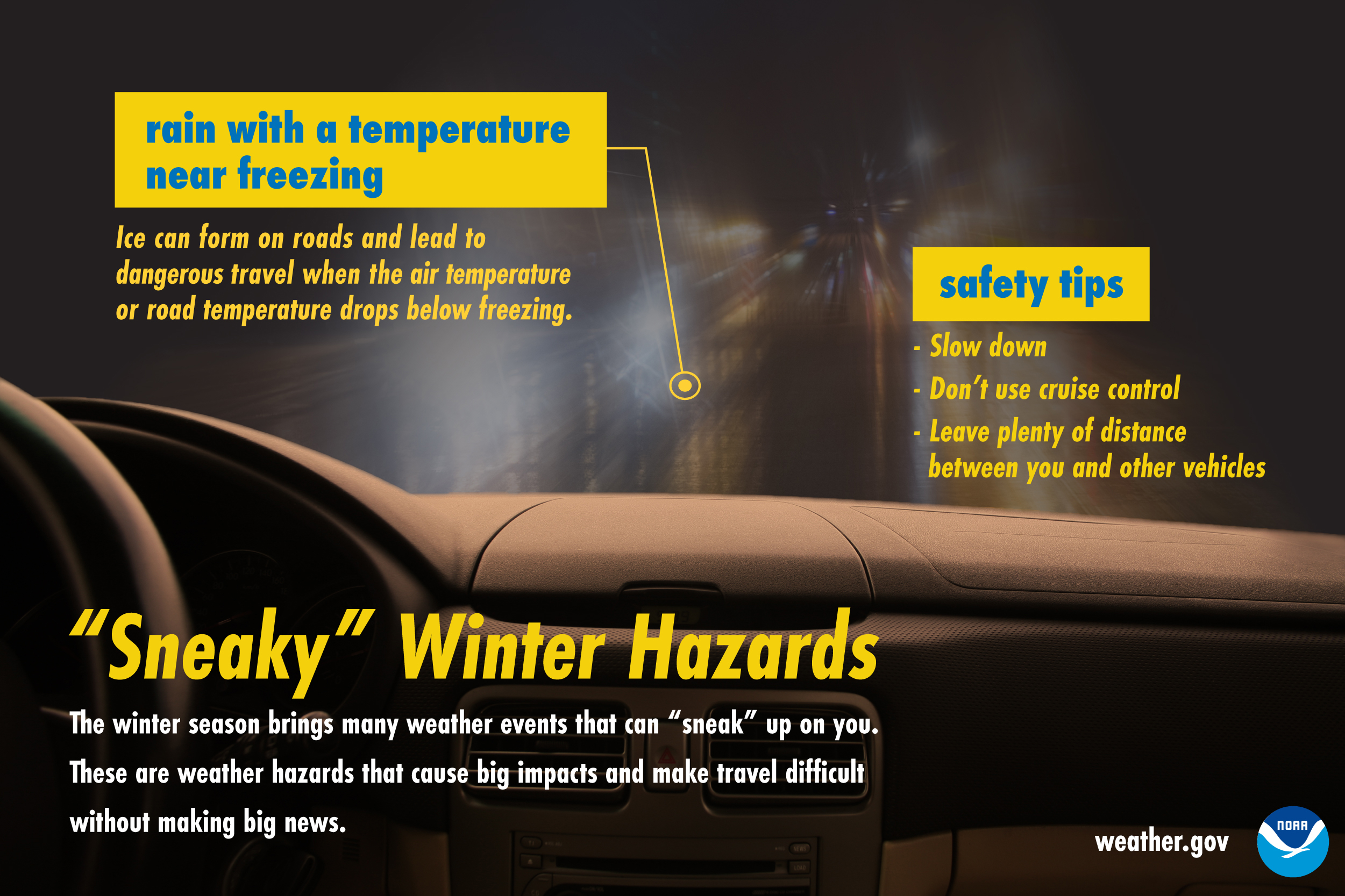
![]()
Freezing Drizzle
Facebook
When surface temperatures are below freezing, drizzle will form a thin layer of ice on the roads. This difficult-to-see ice can cause very dangerous travel conditions. When it's drizzling in the winter, slow down, don't use cruise control, and keep your distance from other vehicles. Don't let freezing drizzle sneak up on you!
Twitter
Freezing drizzle can cause difficult-to-see ice to form on roads, creating very dangerous travel conditions. When it's drizzling in the winter, slow down! Don't let freezing drizzle sneak up on you. #WeatherReady
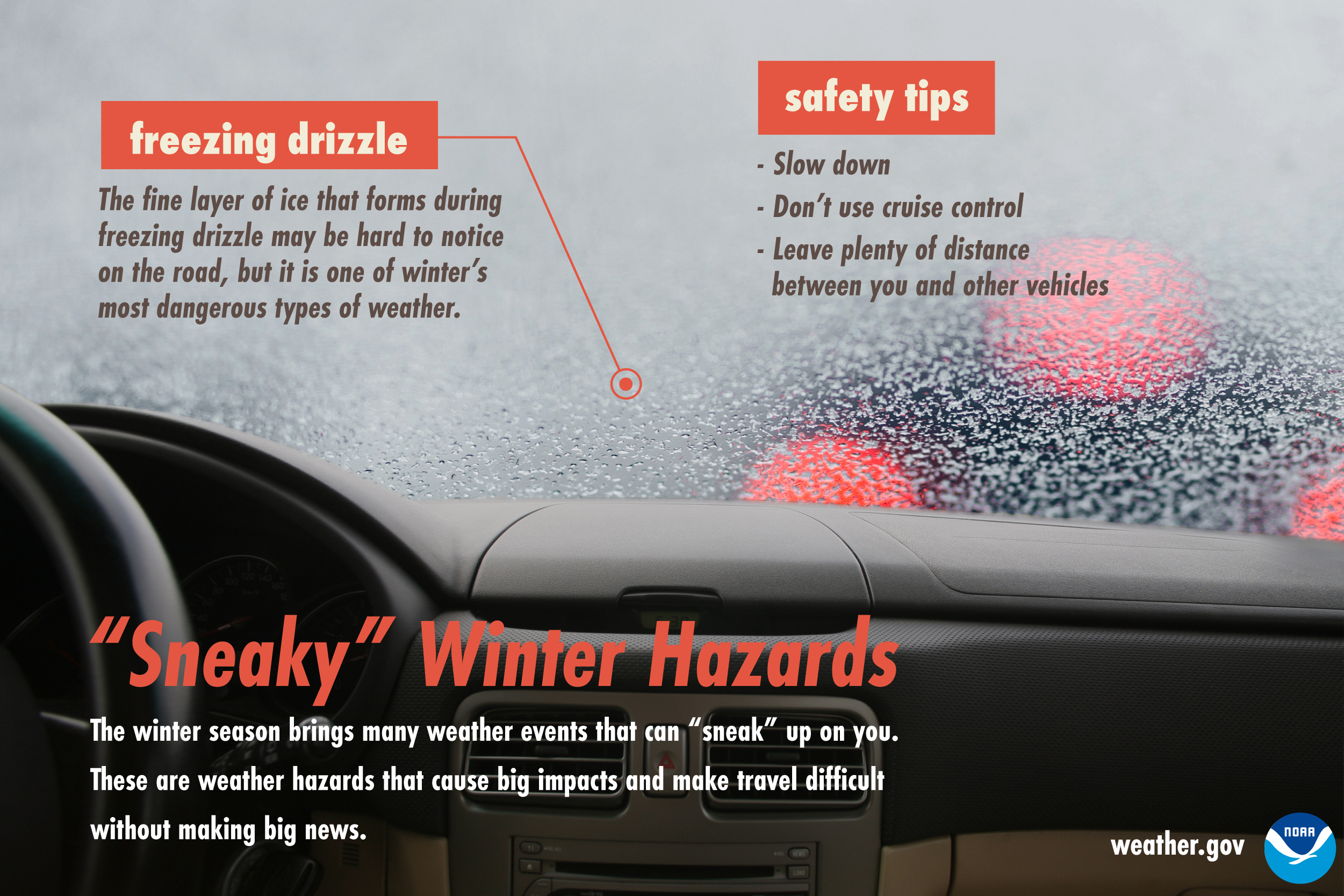
![]()
Flash Freeze
Facebook
Even when it's not precipitating, wet roads can quickly turn icy as temperatures dip below freezing. These unexpected slippery conditions can make driving hazardous. When roads look wet in the winter, stay cautious, slow down, and don't use cruise control. Don't let flash freezes sneak up on you!
Twitter
Wet roads can quickly turn to ice as temperatures fall below freezing. Slow down and don't use cruise control. Don't let flash freezes sneak up on you! #WeatherReady
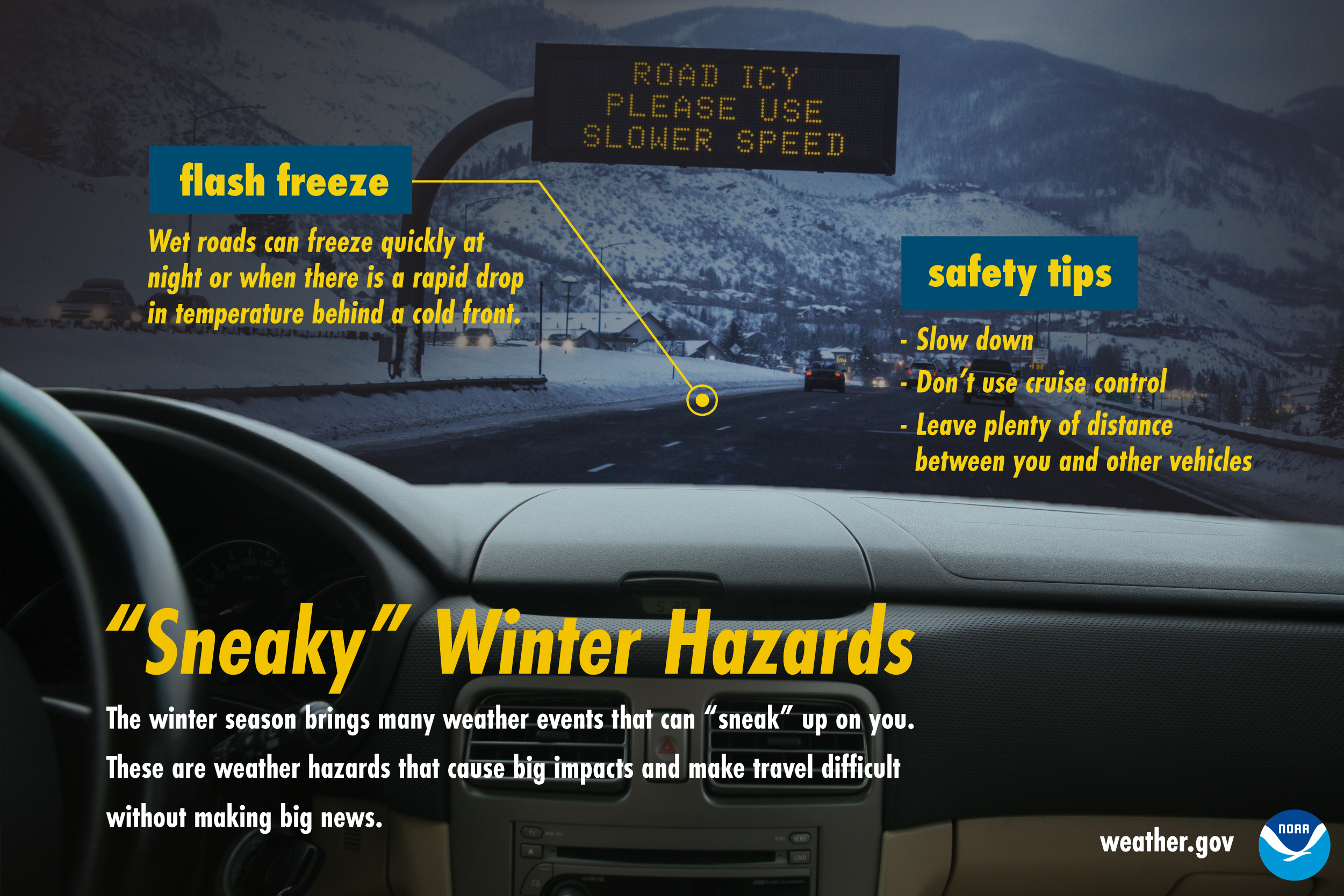
![]()
Rain After a Long Dry Stretch
Facebook
You wouldn't think a little bit of rain could make the roads slippery, but after a long dry stretch, it can happen. This is because oil and debris accumulate on the road during the dry period. Once the rain starts falling, roads become slick. Slow down in these situations. This is one of those hazards that can sneak up on you!
Twitter
When it rains after a long dry stretch, roads can become surprisingly slippery. Don't let this hazard sneak up on you! Slow down and don't use cruise control. #WeatherReady
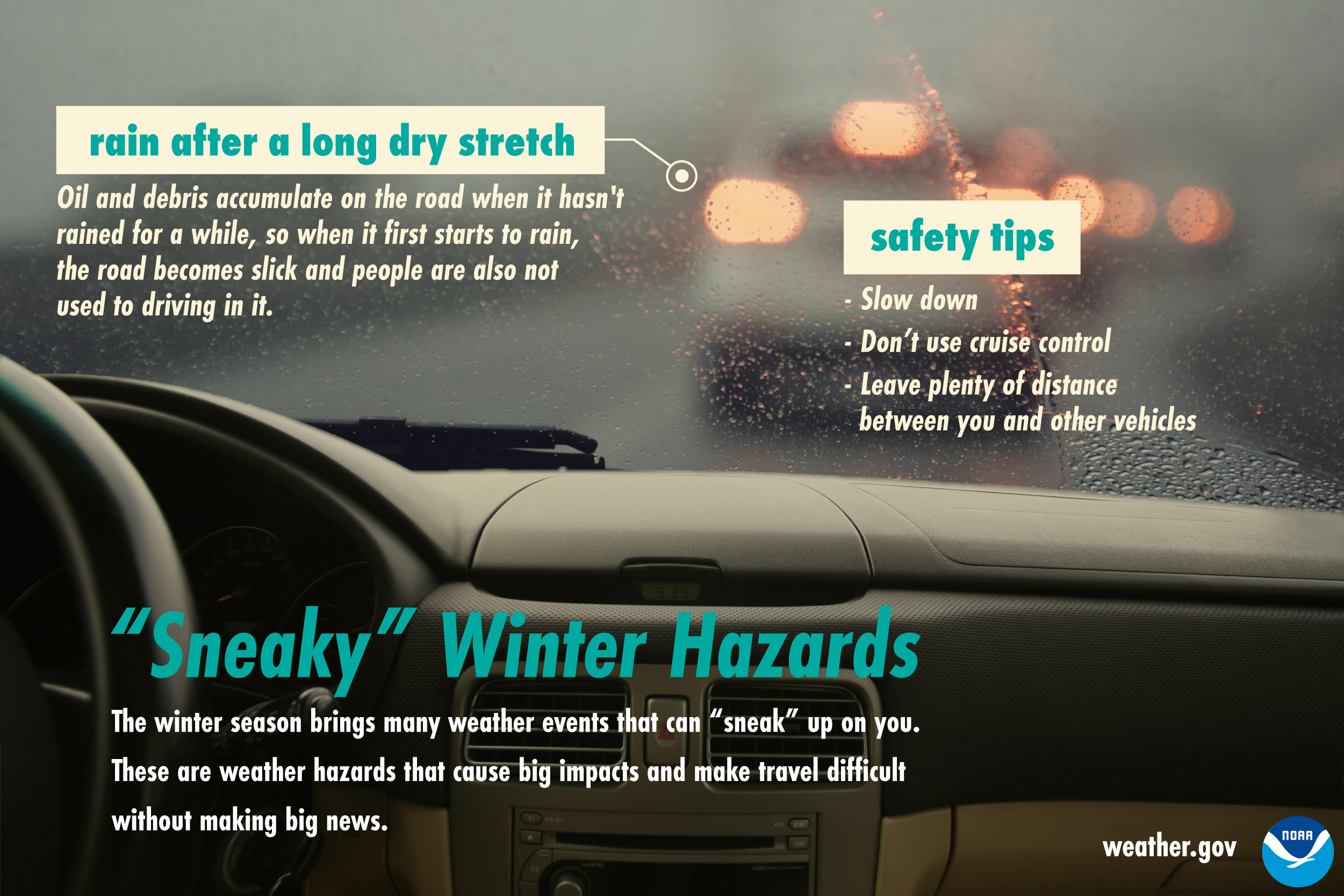
![]()
Dense Fog
Facebook
Visibility can change quickly in fog, creating hazardous driving conditions. Slow down, use your low-beam headlights, and leave plenty of distance between you and other vehicles. Don't let fog sneak up on you!
Twitter
Watch out for quickly changing visibility in fog. Use your low-beam headlights, slow down, and keep your distance from other vehicles. Don't let fog sneak up on you! #WeatherReady
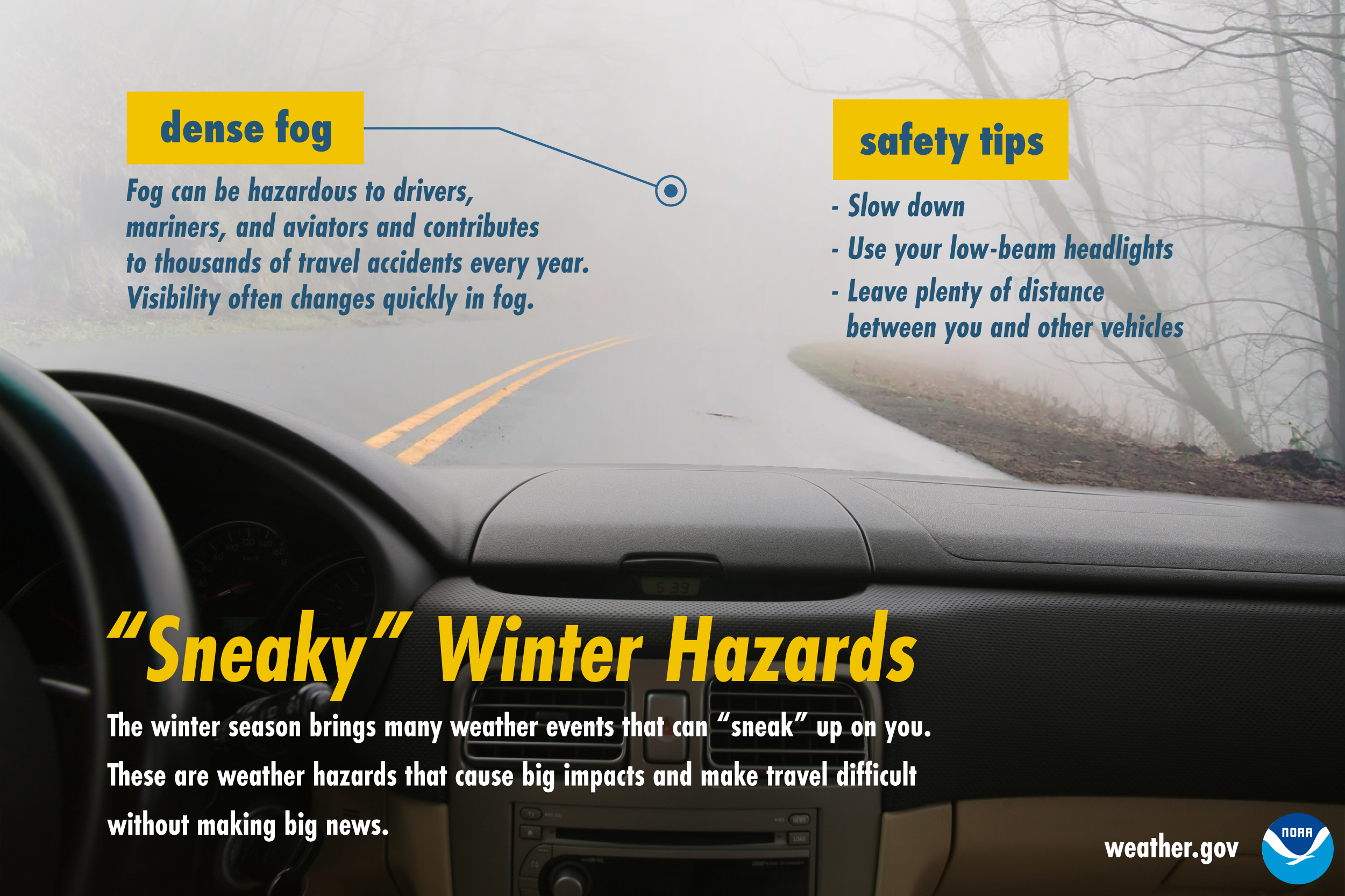
![]()
Snow Squalls
Facebook
Snow squalls are short, intense bursts of snow and wind that can catch people off guard. They can reduce visibility and cause dangerous travel conditions. If possible, avoid or delay travel until the squall passes. If you're caught in one, slow down, turn on your headlights and hazard lights, and try to exit the road. Don't let snow squalls sneak up on you!
Twitter
Snow squalls are short, intense bursts of snow and wind that can reduce visibility and cause dangerous travel conditions. Delay travel if possible. Don't let snow squalls sneak up on you! #WeatherReady
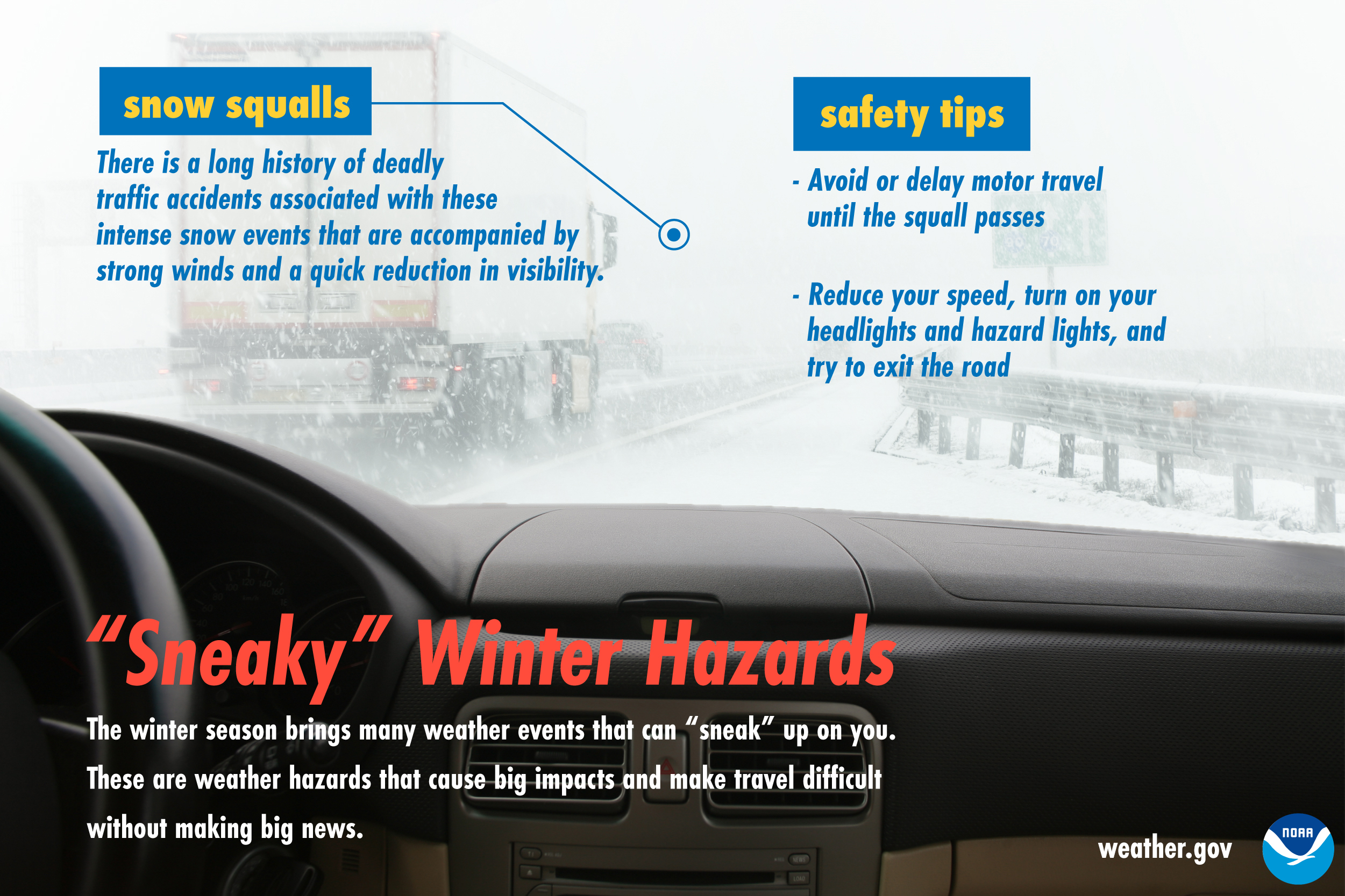
![]()
Ice and Snow, Take it Slow
Facebook
Winter driving can be hazardous. One simple way to keep yourself and everyone on the road safe is to slow down. Remember, "Ice and snow, take it slow". Learn more at weather.gov/winter
Twitter
Do your part to keep everyone safe on the roads this winter. Learn more at weather.gov/winter #WeatherReady
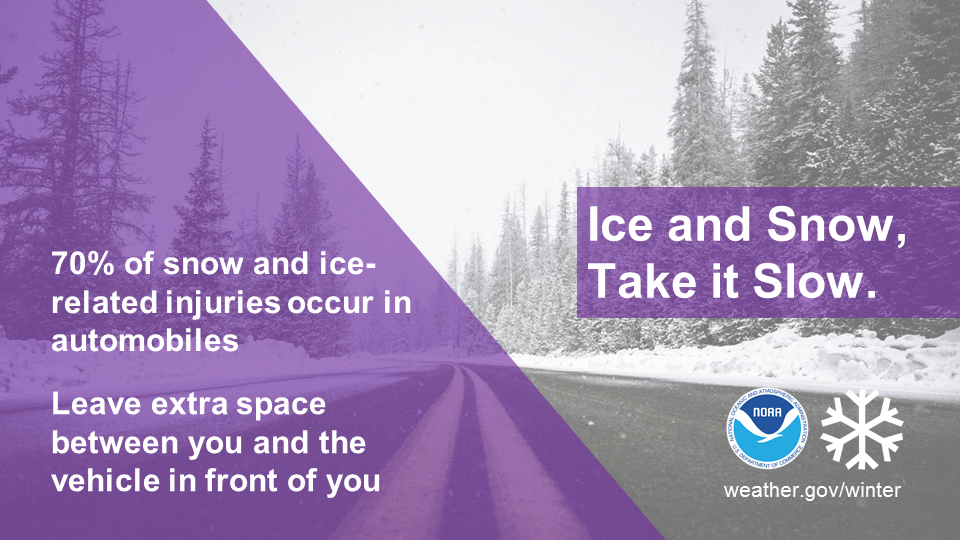
Source: https://www.weather.gov/wrn/winter-driving-sm